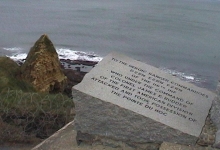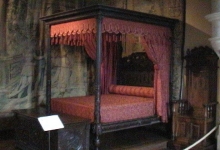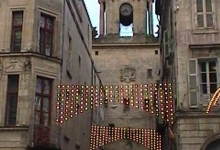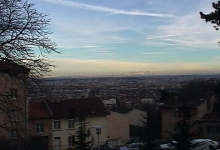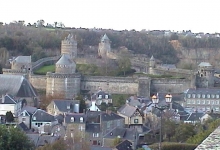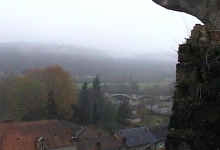Sunday we visited the Memorial de Caen. It’s a museum which relates the events which lead up to the D-Day landing, and has a memorial to the Canadian and American soldiers in the gardens behind it. The British are currently building a memorial. More Canadians were actually killed liberating Caen than on D-day itself.
After the museum we walked around the garden behind it with the memorial to the falled Canadia troops. There’s a large slab of black stone with a Latin inscription. It’s a Virgil quote meaning "Nothing shall ever blot you from the memory of time". The yellow maple leaves falling everywhere in the constant drizzle seemed fitting. Next we headed out to visit the Canadian War Cemetery at Beny-Sur-Mer-Reviers. The cemetery is in the middle of the countryside, surrounded by farms. Driving up to it we were sure we were lost. There were no sign we could see. No buildings, no people anywhere. We were so sure we were lost that we actually pulled over to try to figure out which way to go when looking around for a sign – any sign that would tell us where we were. That’s when we saw maple trees. Bright yellow – their fall color standing out starkly in the midst of the French countryside.
Next we headed out to visit the Canadian War Cemetery at Beny-Sur-Mer-Reviers. The cemetery is in the middle of the countryside, surrounded by farms. Driving up to it we were sure we were lost. There were no sign we could see. No buildings, no people anywhere. We were so sure we were lost that we actually pulled over to try to figure out which way to go when looking around for a sign – any sign that would tell us where we were. That’s when we saw maple trees. Bright yellow – their fall color standing out starkly in the midst of the French countryside.
 On June 6, 1944 Canadian forces landed on Juno Beach. Many of them never made it home and are buried in the Canadian Cemetery. There are more than 2,000 fallen soldiers buried there. The constant light rain kept bringing down more and more yellow maple leaves which lay in drifts blanketing the base of the tombstones.
On June 6, 1944 Canadian forces landed on Juno Beach. Many of them never made it home and are buried in the Canadian Cemetery. There are more than 2,000 fallen soldiers buried there. The constant light rain kept bringing down more and more yellow maple leaves which lay in drifts blanketing the base of the tombstones.







